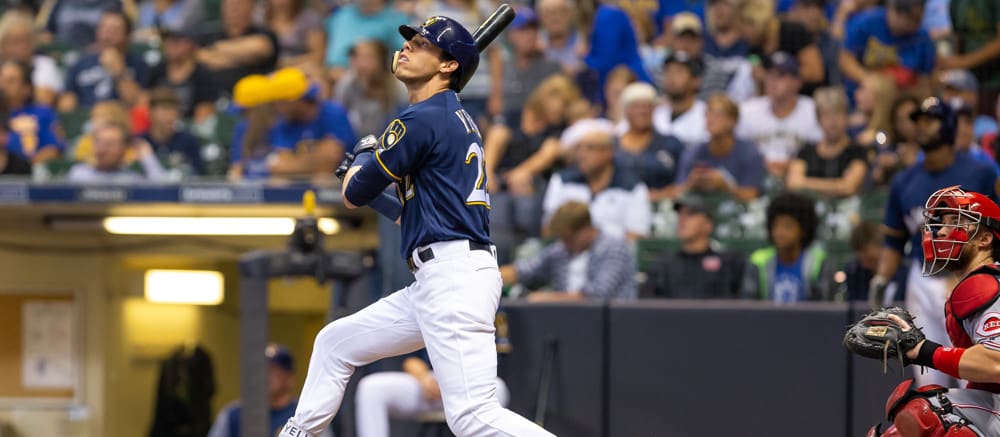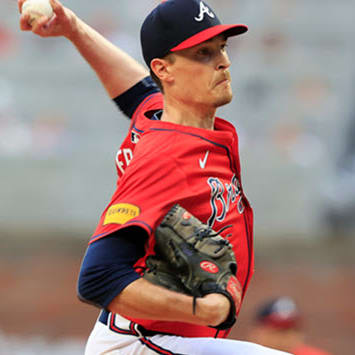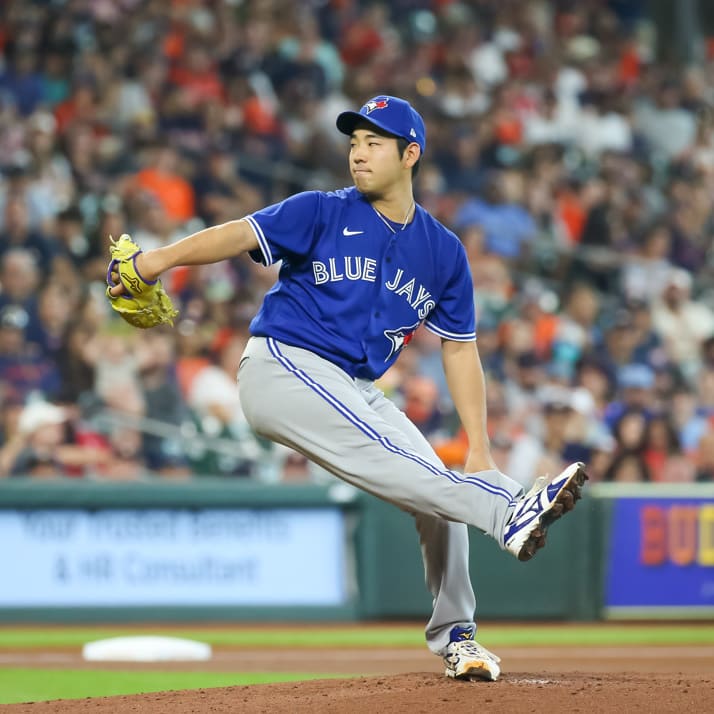This article is part of our Collette Calls series.
Yelich has a career groundball to flyball ratio of 2.93 for his career. Only Ben Revere and Derek Jeter have higher rates for players that have seen at least 2500 plate appearances since the start of the 2010 season. His career 20 percent flyball rate is also only bested by the aforementioned Revere and Jeter. Hitting 30 home runs is hard to do when such a high percentage of a hitter's batted balls have negative launch angles. Coming into 2018, there were eight instances of batters with at least 15 home runs who also had groundball to flyball ratios over 2.0 and sub-25 percent flyball rates:
| SEASON | BATTER | HR | GB/FB | FB% |
| 2017 | Eric Hosmer | 25 | 2.5 | 22 |
| 2016 | Christian Yelich | 21 | 2.8 | 20 |
| 2005 | Derek Jeter | 19 | 2.9 | 21 |
| 2015 | Starling Marte | 19 | 2.4 | 23 |
| 2009 | Derek Jeter | 18 | 2.5 | 23 |
| 2002 | Derek Jeter | 18 | 2.5 | 22 |
| 2003 | Jacque Jones | 16 | 2.8 | 21 |
| 2012 | Derek Jeter | 15 | 3.9 | 16 |
Jeter making up half of the list should come as no surprise, given his inside-out swing and the comically short porch in
Yelich has a career groundball to flyball ratio of 2.93 for his career. Only Ben Revere and Derek Jeter have higher rates for players that have seen at least 2500 plate appearances since the start of the 2010 season. His career 20 percent flyball rate is also only bested by the aforementioned Revere and Jeter. Hitting 30 home runs is hard to do when such a high percentage of a hitter's batted balls have negative launch angles. Coming into 2018, there were eight instances of batters with at least 15 home runs who also had groundball to flyball ratios over 2.0 and sub-25 percent flyball rates:
| SEASON | BATTER | HR | GB/FB | FB% |
| 2017 | Eric Hosmer | 25 | 2.5 | 22 |
| 2016 | Christian Yelich | 21 | 2.8 | 20 |
| 2005 | Derek Jeter | 19 | 2.9 | 21 |
| 2015 | Starling Marte | 19 | 2.4 | 23 |
| 2009 | Derek Jeter | 18 | 2.5 | 23 |
| 2002 | Derek Jeter | 18 | 2.5 | 22 |
| 2003 | Jacque Jones | 16 | 2.8 | 21 |
| 2012 | Derek Jeter | 15 | 3.9 | 16 |
Jeter making up half of the list should come as no surprise, given his inside-out swing and the comically short porch in right field he could aim at with regularity. He hit 39 of his 70 homers over those four years at Yankee Stadium, and 22 of those went to right field. Jeter was the only batter to show up on this list twice until Yelich did what he has done in 2018. Jeter had the cozy confines of Yankee Stadium, and Yelich did change from a park that suppresses homers to one that enhances it. Yet, it cannot be as simple as that.
The premise of my 30 homer prediction for Yelich back in early February was as follows:
Yelich has never hit more that 21 homers in a season, mostly because he hits a crazy amount of groundballs for someone who does not make his living solely on this legs. Perhaps he had that approach because he knew how challenging his home ballpark was for guys not named Stanton or Ozuna. The last three seasons, one of every 20 flyballs Yelich hit at home became a home run while one of every 13 did so on the road. His flyball rate has increased each of the previous three seasons, albeit from a minuscule 15 percent to a still-low 25 percent last year.Yelich hit 33 flyballs at home last season, nearly matching his total of 36 from the previous two seasons.,, Yelich has shown more opposite-field power in his career with his swing as he rarely yanks pull shots, but now that the gap in right-center field is 18 feet closer, maybe he adjusts his swing. Even if he does not, the opposite field gap just got 13 feet closer too. It is not unusual for players to flip the switch into launch mode from one season to the next as the likes of Yonder Alonso and Logan Morrison showed us just last season. Throw in nine road games in Wrigley Field (plus-22 percent for LHB HR), Great American Ballpark (plus-23 percent for LHB HR), and the new home park and the path to 30 homers does not look like a pipe dream.
Yelich has not raised his groundball to flyball ratio at all. In fact, it has dropped from 2.2 in 2017 to 2.4 this season. His flyball rate dropped from 25 percent to 23 percent this season, ending the three-year trend of an improving flyball rate. His average launch angle is still a very low single-digit figure at 4.2, which is a step back from his 4.2 of 2017.
What has changed is that when he puts the ball into play, expected weighted on-base average on contact (xwOBACON; hear the sizzle?) is .492, which is nearly a 100 point jump over last season. That will happen when a batter increases their percentage of barrels as Yelich has done this season, jumping from seven percent of his batted ball events up to 12 percent of his batted ball events. Ultimately, I believe this home run accomplishment in 2018 is due to his quality of contact, because most of my hypothesis in February has not developed.
Yelich has not changed how frequently he lofts the ball, nor has he even changed how frequently he has pulled the ball. The charts below are the spray charts for his homers; the left shows 2015 to 2017 while the right focus on just this season:

The chart has no discernable difference in the spray chart other than Yelich can still hit the ball out to all fields. If anything, he is pulling a lower percentage of his home runs this year and hitting more to the middle third of the field than he has done in previous seasons.
He has enjoyed home-field advantage in 2018 as the 18 home runs he has hit at Miller Park match the 18 homers he hit in Miami home games over the previous four seasons. He has but one dead pull home run at Miller Park this season, three to right center, while the other 15 have gone to center or left-center field:

The homers that Yelich hit in Marlins Park were mostly of the pull variety as 11 of his 18 homers over the previous four seasons were to right or right-center field:

Recall that Yelich rarely hit flyballs with Miami. When he did, they were either no-doubt pull shots to right and right-center, or they were hit to the opposite field. His spray chart for flyballs as a Marlin look like something you would expect from J.D. Martinez or Khris Davis and not a lefty hitter:

Now, compare the image above to the exact same data points, but overlayed onto Miller Park dimesions. Pay particular attemtion to the cluster of points to dead center and left-center:

This was the one part of my February hypothesis that held up. Miller Park would be more forgiving to Yelich's non-pull approach to his flyballs and that some of those doubles and long outs would become home runs. Yelich has not been as oppo-heavy with the flyballs he has hit this year, and due to the harder contact he is making, 18 of the 37 flyballs he has hit at home this year have become souvenirs:

The great news is that Yelich will play in Milwaukee the next few seasons, and he has found that his power truly can play to all fields in Miller Park where it did not in Marlins Park. He has not had to change his swing or loft to get the new results in 2018. He kept doing what he was doing mechanically, but the new park and a more aggressive approach early in the count have put him in the forefront of the NL MVP chatter this fall and made his ADP of 50 this past draft season end up looking like a bargain.










